Oct 19, 2024 – Environmental Dharma Talk, Youth Gyeongju Unification History Tour Day 1
Good morning. A new day has dawned at the Dubuk Retreat Center.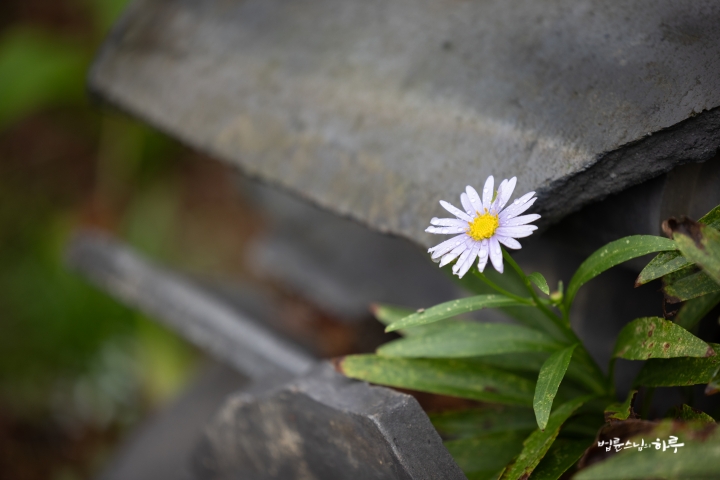
After completing his early morning practice and meditation, Sunim began his day by having breakfast with the elderly Korean-Chinese from Yanbian at 6:30 AM.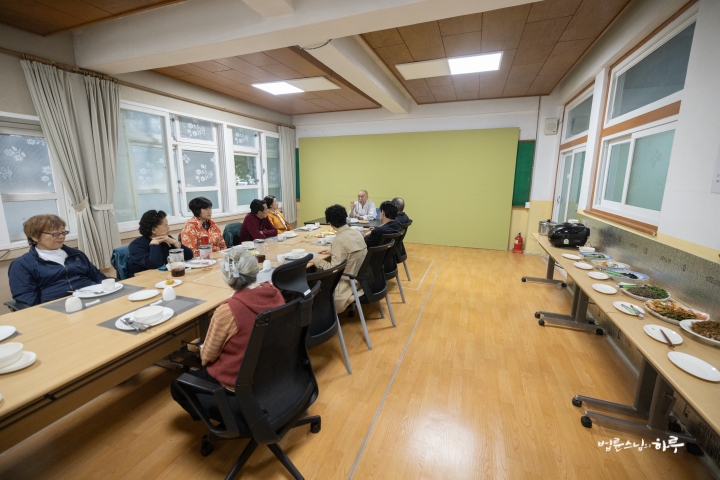
The Korean-Chinese elders had been staying at the Dubuk Retreat Center for the past two days, engaging in numerous conversations with Sunim. After finishing breakfast, they continued their discussions and took commemorative photos together.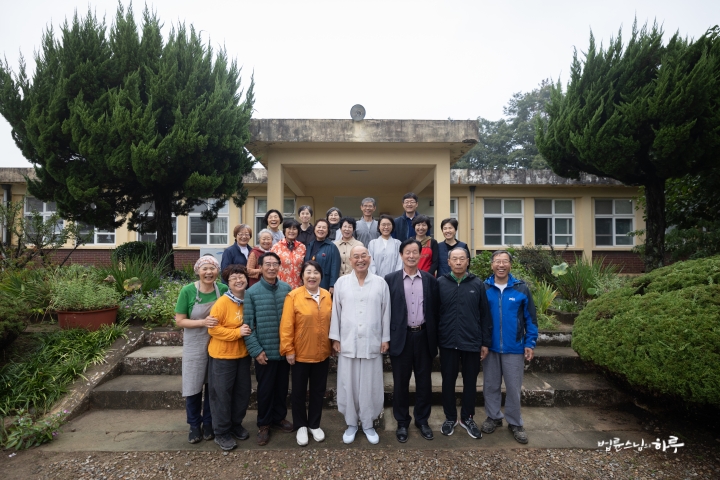
After seeing off the Korean-Chinese elders leaving for Seoul, Sunim promised to meet them again. 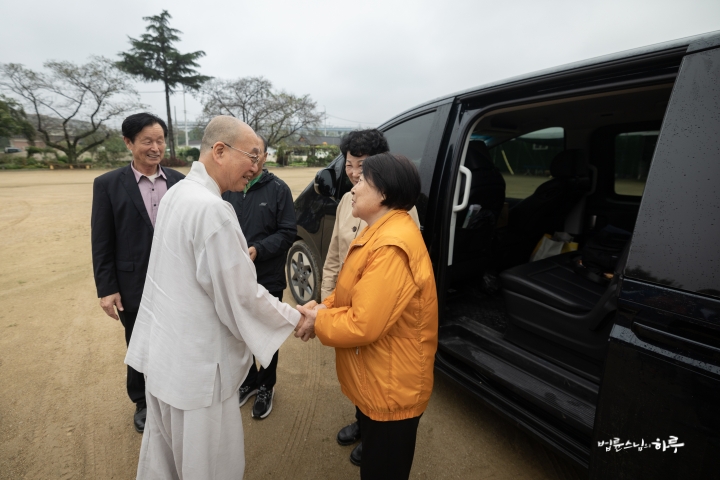
“Get home safe. I’ll visit you again when I go to Yanbian next year.”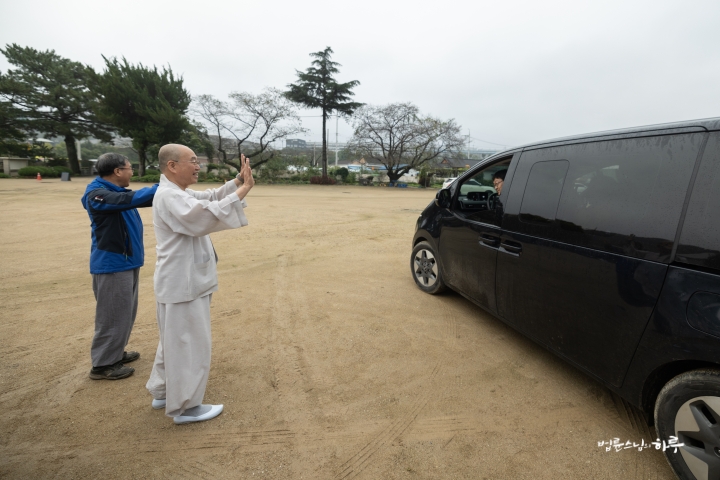
From 10 AM, Sunim joined Jungto Society’s Environmental Dharma Talk online from the broadcasting room at the Dubuk Retreat Center. For today’s event, people interested in environmental practices gathered at Jungto Society’s main temples nationwide.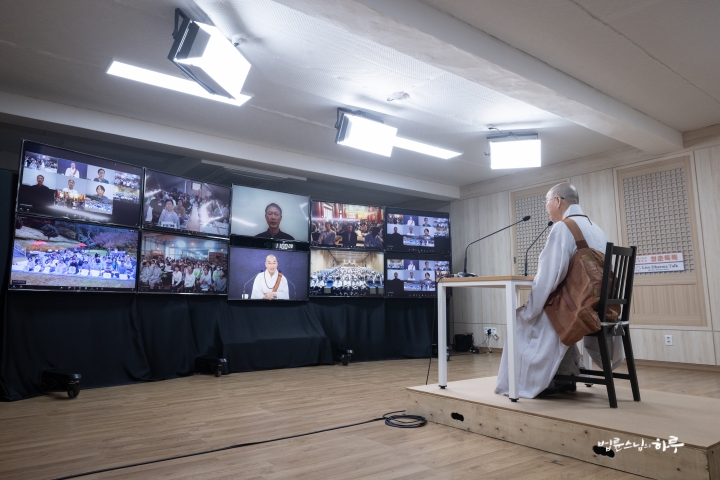
The broadcasting room at the Dubuk Retreat Center was connected via live online broadcast to the main temples of Jungto Society across the country for discussions. Sunim first gave opening remarks on what practices we should adopt in response to the climate crisis.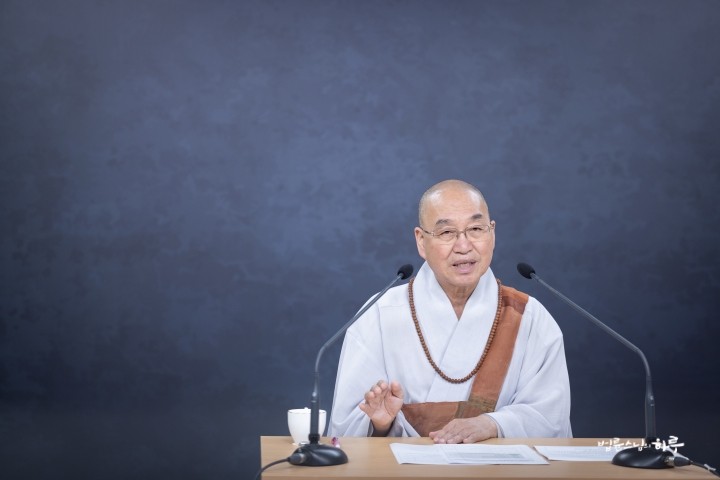
“Today, we are taking time to reflect once again on the environmental movement that Jungto Society has been pursuing since its foundation. When Jungto Society was established and began its first 10,000-Day Practice, we set four main objectives. First, on a global scale, we must prevent environmental pollution to prepare for the climate crisis. Second, on a humanitarian level, we must eradicate poverty. Third, on the Korean Peninsula, we must prevent the risk of war and achieve peace and unification. Fourth, individuals should be able to live happy lives through practice. Thus, environmental issues are embedded in the founding spirit of Jungto Society.
To overcome the environmental crisis, what we need to do is, first, to start practicing environmental conservation ourselves. Second, we need to expand our sphere of influence because it’s not enough for just one person to act. Third, we must not only expand our sphere of influence but also encourage local governments, businesses, and nations to institutionally support environmental conservation. Fourth, it’s not enough for just our country to do well; we need to work through international relations to ensure that all of humanity engages in environmental practices together. At the same time, we must also engage in recovery efforts where damage has occurred. We need to follow this order in our environmental practices.”
Following this, participants from the main temples nationwide asked questions, and Sunim answered from the broadcasting room at the Dubuk Retreat Center. Various questions about environmental practices continued for an hour.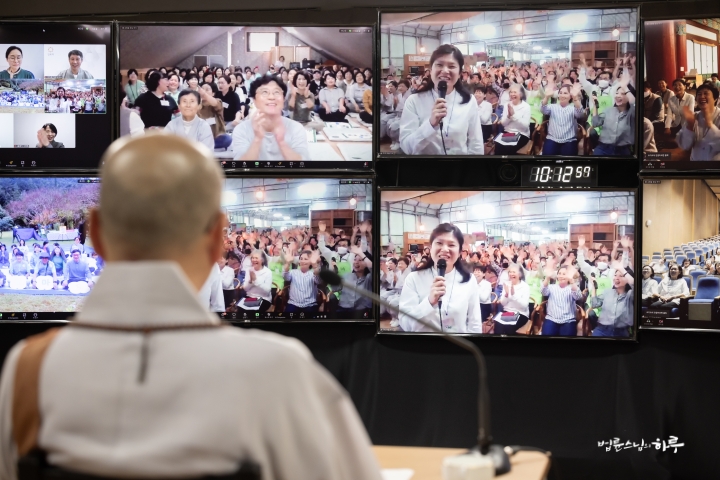
I’m Worried About the Amount of Waste Generated When Ordering Delivery Food
“It’s true that environmental problems can’t be solved by your efforts alone. That’s correct. However, if everyone on this planet thinks that way, ultimately nothing will be solved. But if you have the mindset of ‘Even if others don’t do it, let me try it alone,’ and take even one action, it can help, even if it’s just one in ten thousand or one in a hundred million. As more and more individuals participate like this, 1% of the population will join, and as these results accumulate, 10% of the population will participate, leading to change.
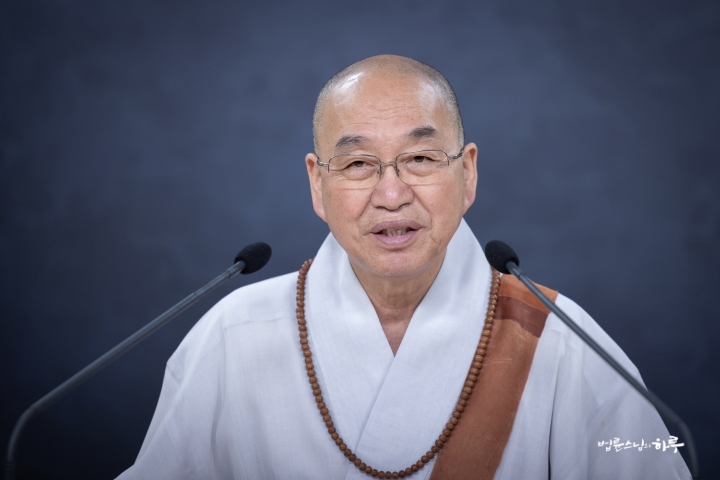
Of course, individual actions alone won’t bring about immediate change. However, we can overcome the environmental crisis if we all reduce our consumption, even by a little. We could choose to simply accept this crisis and perish together. Some might think, ‘Let’s spend recklessly, and if floods from climate change wash away our homes, we’ll all die together anyway.’ That’s one way to live. If we don’t like that option, we should at least try to build levees in advance, or if that fails, attempt to escape to the mountains. The point is, there are only these two paths available to us.
In such times, the only option we have is to start with ourselves by stopping or reducing consumption. If there were a better method, we could do that instead. But currently, this is our only choice. Of course, it would be much more effective if the president and the National Assembly created laws and the government implemented institutional measures. However, we don’t have the ability to influence the government directly. Therefore, at present, the only thing we can do is to reduce our own consumption. There’s no other way.
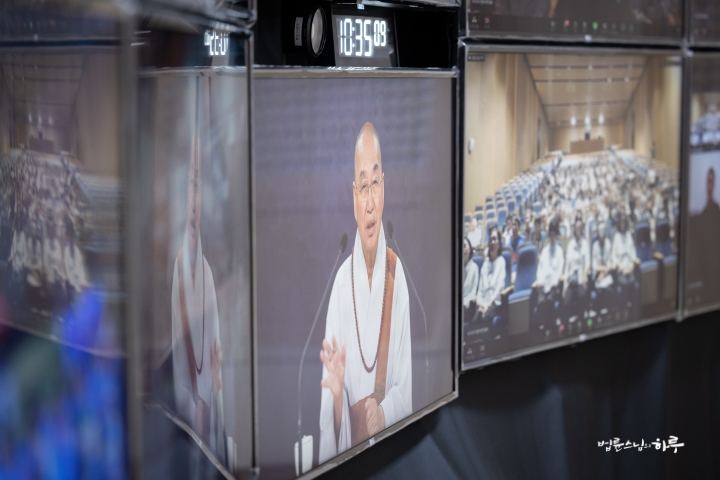
That’s why Jungto Society is promoting a movement to start with ourselves and our community, rather than worrying about what others are doing or not doing. If we don’t stop here but spread the word to those around us, and as it expands to a wider group of people who can influence elections, we can even bring about institutional changes. To prevent the environmental crisis, we have no choice but to carry out our activities in this order.
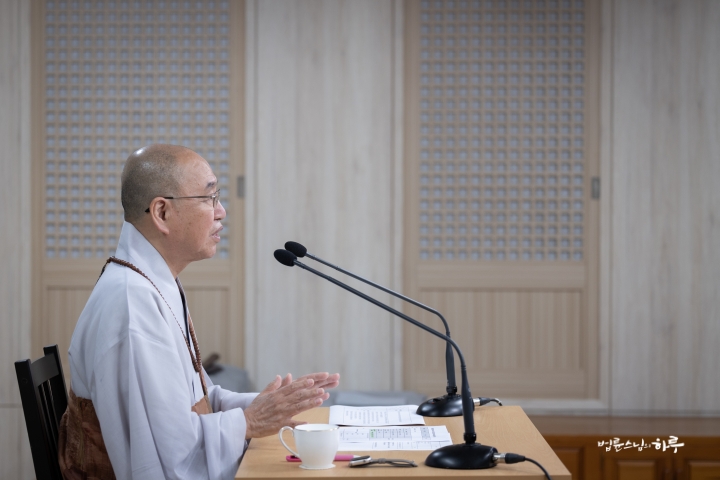
Among the waste we discard, the most serious risk factor is microplastics. When plastic breaks down, it turns into invisible microplastics, which are eaten by fish and then return to our bodies. As these accumulate, they seriously harm our health. Unbroken plastics float into the sea, and it’s said that these have formed a garbage island in the North Pacific Ocean about ten times the size of the Korean Peninsula. While a lot of garbage accumulates on coastal areas where people live, it can be cleaned up. However, in the middle of the ocean where there are no people, we don’t even know it exists because we can’t see it. But garbage inevitably accumulates somewhere on Earth. Unbroken items pile up wherever they end up, and broken items seep into the soil and water. So as time passes, it gradually accumulates, and its side effects come back to us.”
“Thank you. I understand well.”
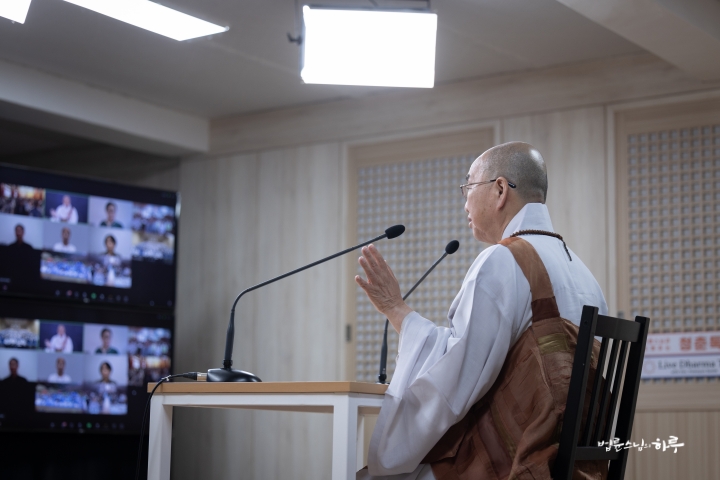
After concluding the environmental Dharma talk with the Four Great Vows, each main temple proceeded with its own prepared program. The members had lunch with the packed meals they brought and then experienced various environmental practice booths and watched environmental films.
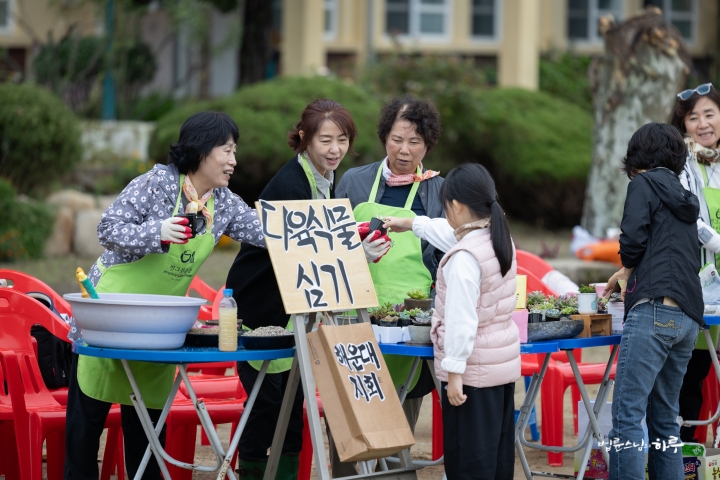
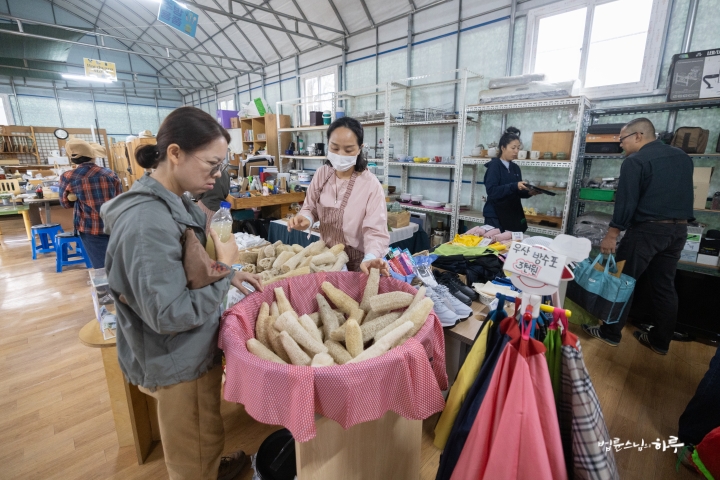
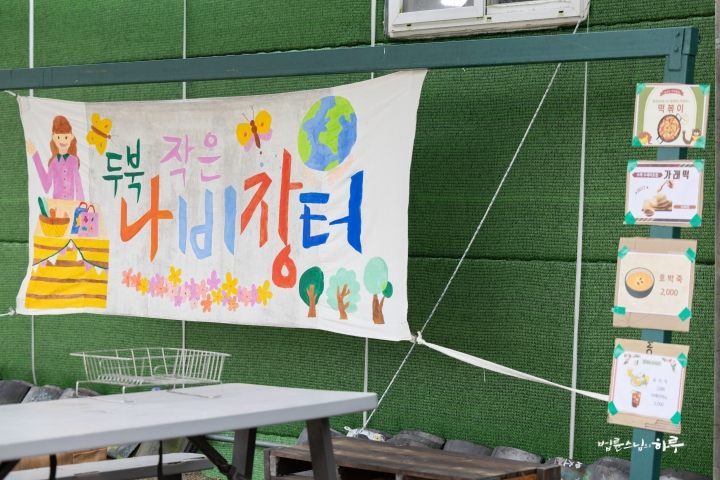
There were many fun booths such as making handkerchiefs, eating vegetarian food, experiencing soil composting, and eating rice cakes in containers. As they enjoyed each experience one by one, their awareness of environmental practices grew significantly.
Sunim took a tour of the environmental booths set up at the Dubuk Retreat Center’s Saligo Center and JTS warehouse.
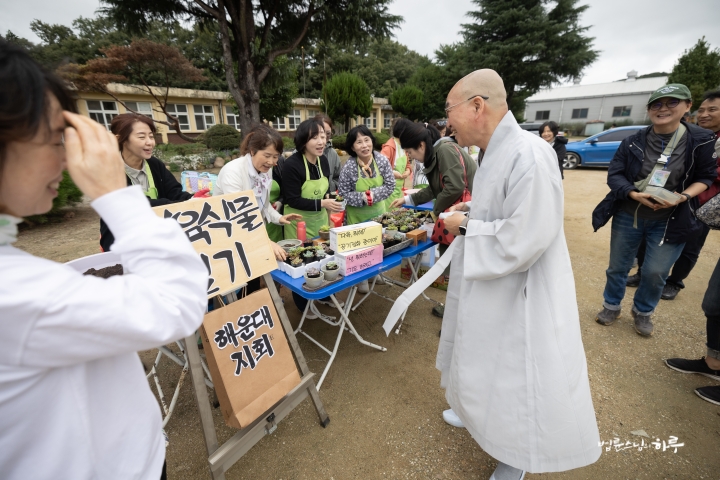
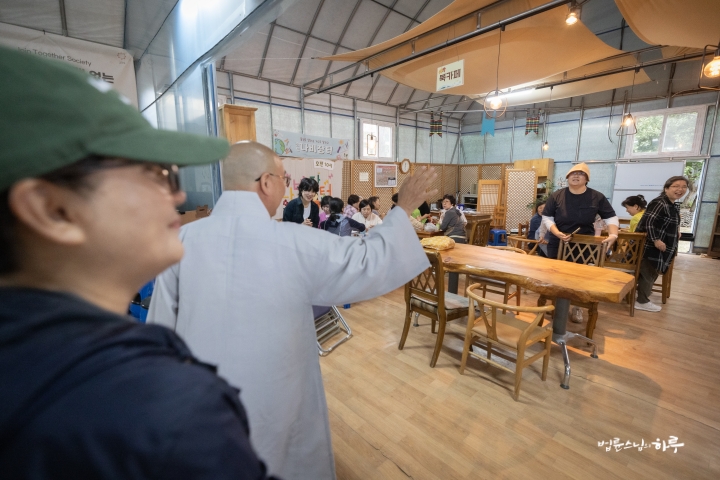
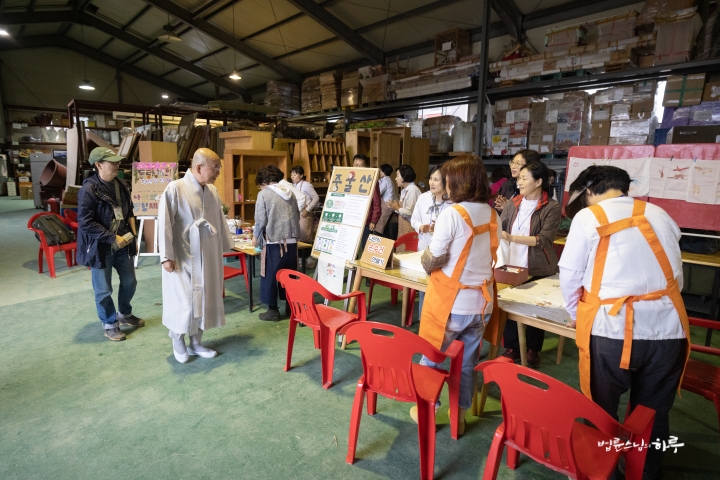
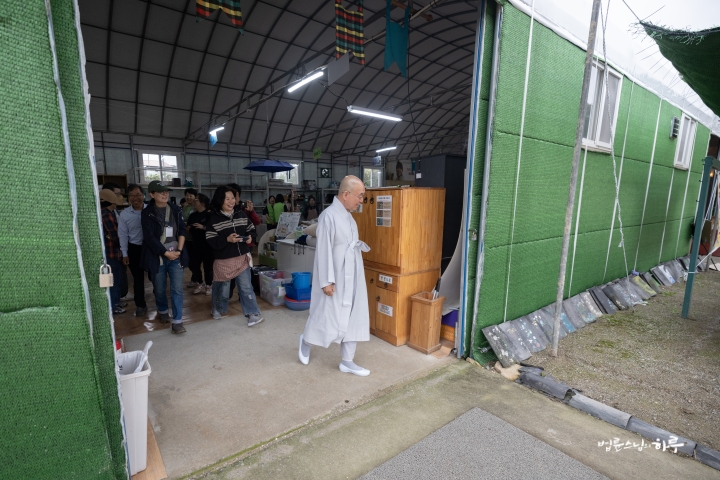
“Thank you all for your hard work!”
After expressing gratitude to the volunteers who had meticulously prepared each experience booth, Sunim immediately headed to King Taejong Muyeol’s tomb to participate in the Unification History Tour with the youth.
About 300 young people from across the country had gathered at King Taejong Muyeol’s tomb for a two-day Unification History Tour with Sunim. Today and tomorrow, Sunim plans to guide them through historical sites in Gyeongju, explaining how to view the current North-South issue, what difficulties might arise in the process of unification, how to overcome these difficulties, and what lessons can be learned from history.
When Sunim arrived at King Taejong Muyeol’s tomb at 1 PM, the young people greeted him with enthusiastic applause.
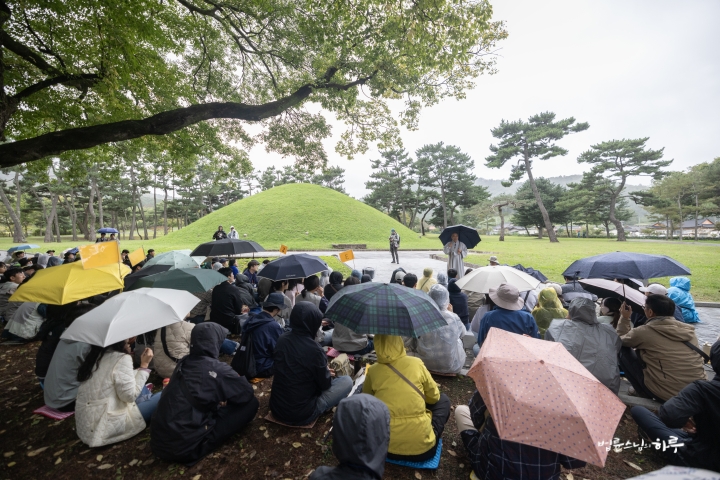
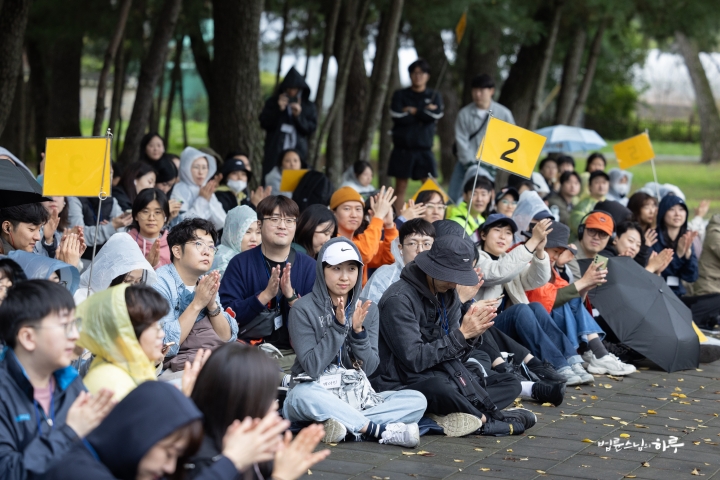
After warmly welcoming each other during the participant introduction time, Sunim explained the purpose of this history tour and discussed how Silla, a small country, was able to emerge as the mainstream of national history. Despite the pouring rain and strong wind, the young people remained fully focused on Sunim’s words.
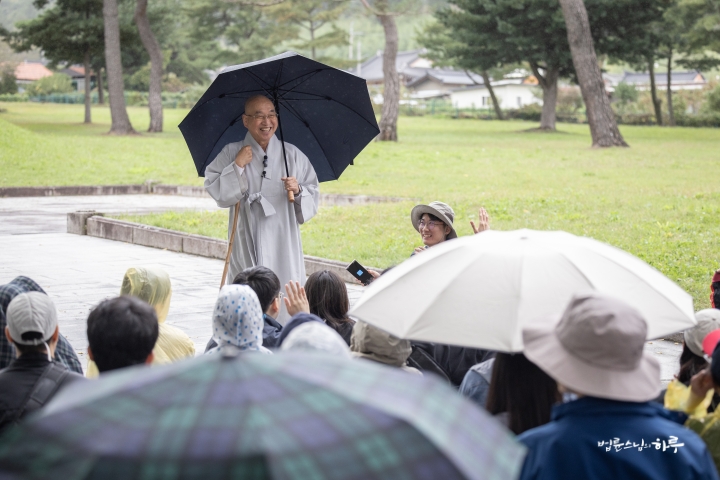
“For the next two days, as we explore the Gyeongju area, we will examine how Silla, a small country in the east, became one of the Three Kingdoms and eventually the main player in their unification. In other words, we will look at how Silla, which was initially just a small force and not the mainstream in our national history, emerged as the historical mainstream. Studying history is not just about knowing the past, but about gaining insights that allow us to wisely deal with our present and future based on the lessons learned.”
How the Small Country of Silla Became the Mainstream of National History
Until around 400 AD, during the reign of King Naemul, Silla was weaker than Gaya. But as Silla gradually grew stronger, Gaya and Wa joined forces to invade Silla. Silla almost lost this war and nearly perished as a nation. At that time, Gwanggaeto the Great of Goguryeo sent 50,000 troops to support Silla and defeated the allied forces of Gaya and Wa. As a result, Silla became a tributary state to Goguryeo. After that, Gaya’s national power gradually weakened. On the other hand, Silla’s national power grew based on its victory in the war. A hundred years later, during the reign of King Beopheung, conflicts between Gaya and Silla increased. In Silla, there was a growing sentiment to “invade and eliminate Gaya,” while Gaya resisted, saying, “We were originally the stronger country, let’s resist to the end.”
However, the young people of Silla thought differently. They argued that now that the country’s power had grown, it was more important to compete with Goguryeo or Baekje rather than wasting national power fighting with Gaya. Some young people in Gaya also argued, “Now that our country is declining, we’ll lose if we fight Silla anyway. Do we really need to fight to the end and be annihilated? It’s better to merge with Silla if they accept our demands through appropriate negotiations.” Both Silla and Gaya had hardline and moderate factions. Looking back at history, the moderate faction’s arguments seem better, but in reality, the hardline faction often has a louder voice. We can see similar patterns in today’s conflicts between North and South Korea. Which voice do you think is louder? “Let’s just push them over!” or “Let’s embrace them with persuasion”? The voice for pushing them over is always louder. Thus, in reality, when there’s a conflict, the hardline faction usually takes the lead.
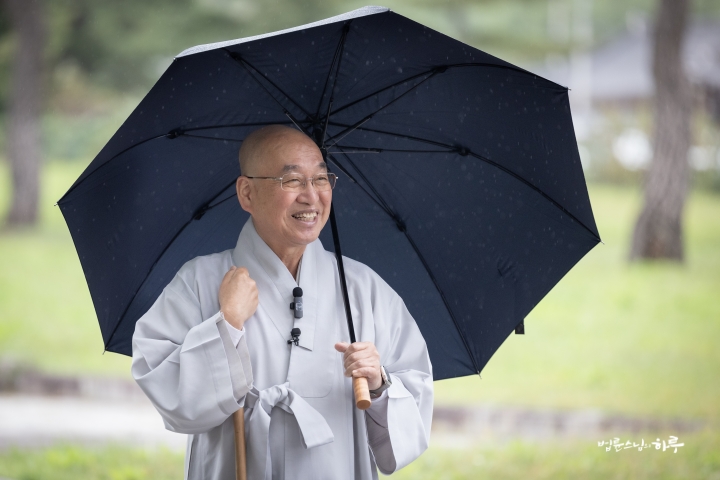
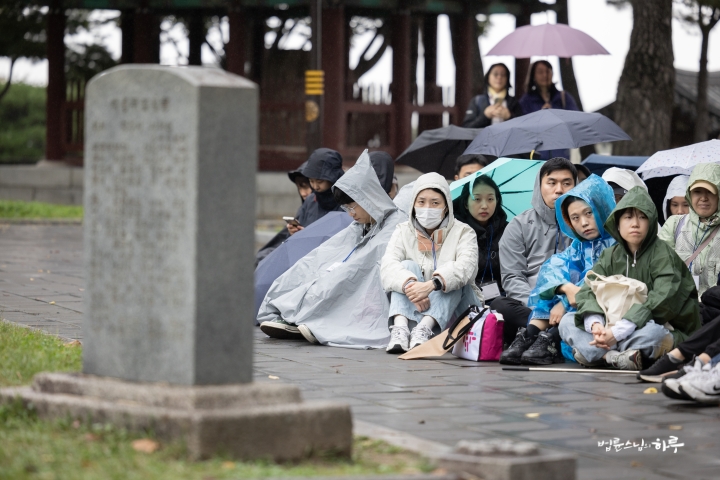
In this situation, one of the negotiation conditions set by Gaya was the official recognition of Buddhism. Gaya had been a Buddhist country since its inception, while Silla was the only country among the three kingdoms that prohibited Buddhism at the time. Due to its geographically isolated position in the east, Silla had not been able to adopt Chinese or other foreign cultures. The situation between Silla and Gaya was similar to today’s confrontation between North and South Korea, with North Korea’s communism and South Korea’s anti-communist policies. In response to Gaya’s demand for national recognition of Buddhism, the younger faction in Silla agreed, but the conservative faction strongly opposed it, arguing that they could never officially recognize Buddhism after prohibiting it for over 100 years.
Another demand from Gaya was the guarantee of status for the Gaya royal family and nobility. In modern terms, this would be like North Korea requesting that the status and qualifications of their governors, military generals, doctors, and teachers be recognized as they are in the event of unification with South Korea. In other words, it was a demand to treat Gaya nobles equally to Silla nobles. Was this an easy demand to accept? If North Korea were to demand the abolition of South Korea’s National Security Act and anti-communist laws, and recognition of all North Korean statuses as a condition for peaceful unification today, would it be easy for South Korea to accept? In the current situation, not only is it unlikely for North Korea to propose unification under such conditions, but it would also be difficult for South Korea to accept such demands. This means that neither South Korea nor North Korea is prepared for peaceful unification.
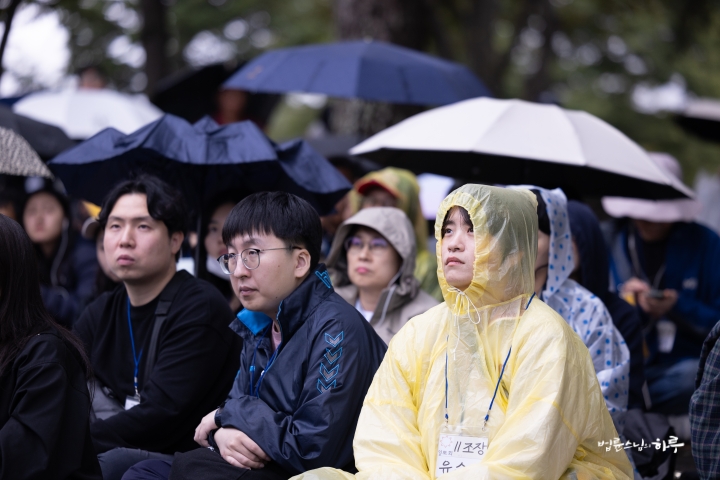
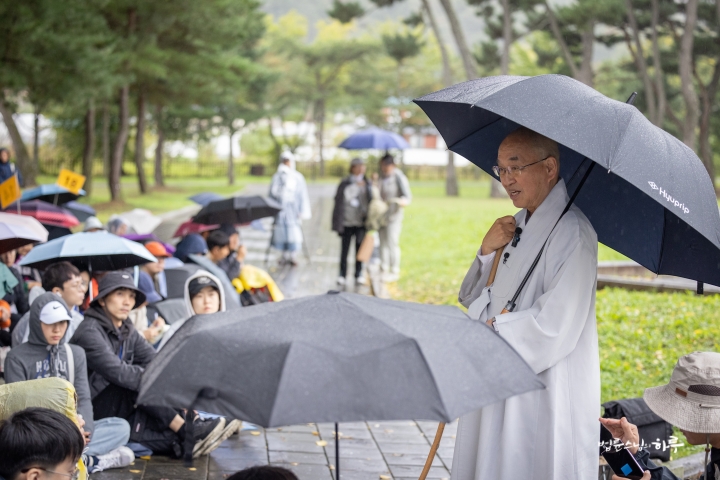
The Synergy Effect of Silla and Gaya Integration
Amidst the controversy surrounding Gaya’s negotiation terms, young people in Silla built Heungnyunsa Temple, even breaking the law. Eventually, the ringleaders were caught, including Ichadon, who was King Beopheung’s secretary. King Beopheung offered to spare Ichadon’s life if he renounced Buddhism, but Ichadon refused and was ultimately executed. One legend about Ichadon claims that white blood flowed from his neck after his martyrdom, and his head flew to Sogeumgangsan Mountain. Another legend states that when dark clouds gathered and mud rained from the sky, people were so astonished that they officially recognized Buddhism. Of course, these stories can be seen as symbols of social phenomena. The sky turning dark as night in broad daylight could be interpreted as a metaphor for public opinion turning against the government. Eventually, in 527, Ichadon’s martyrdom caused a significant shift in public sentiment, leading to the progressive faction taking power. The following year, in 528, Silla officially recognized Buddhism.
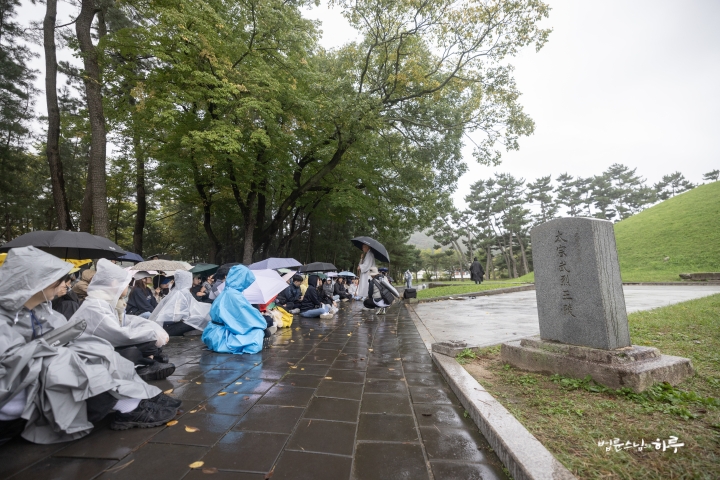
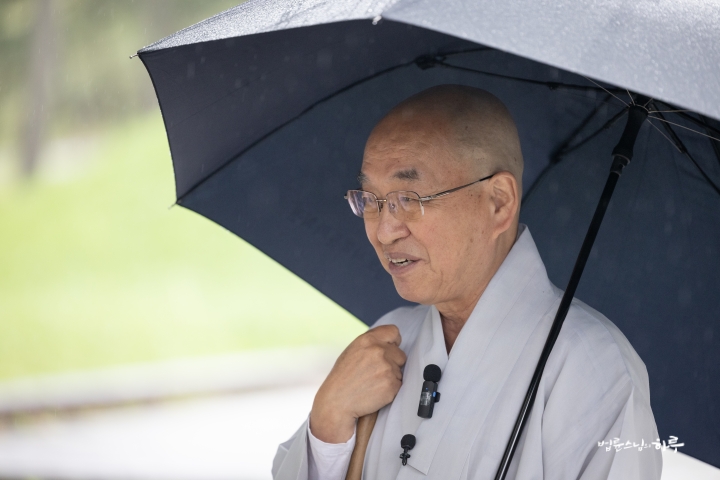
Four years later, in 532, Silla and Gaya unified. Silla accepted all of Gaya’s nobility as their own. Considering the 100-year-old grudge Silla had against Gaya, Silla chose to embrace rather than retaliate against their enemy. As a result, Silla made significant progress by absorbing Gaya’s advanced iron civilization and military capabilities. Most of the generals who made great contributions to Silla’s unification of the Three Kingdoms were from Gaya, including Kim Yu-shin, the great-grandson of King Guhyeong, the last king of Gaya. This peaceful integration of Silla and Gaya brought about a synergistic effect where 1+1 became not just 2, but 3, 5, and even 10.
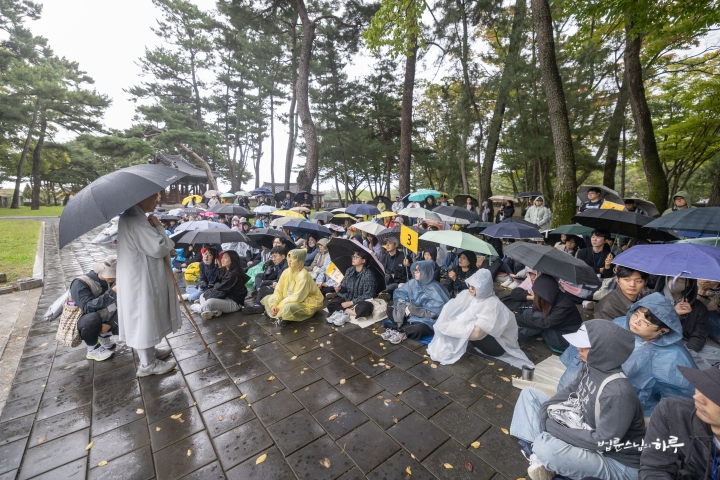
Through these historical lessons, it would be great to spend one night and two days learning together about what perspective we should adopt in dealing with inter-Korean relations today.”
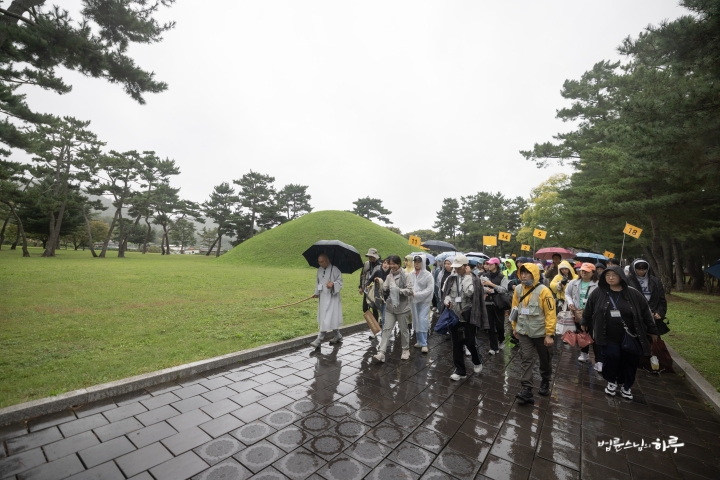
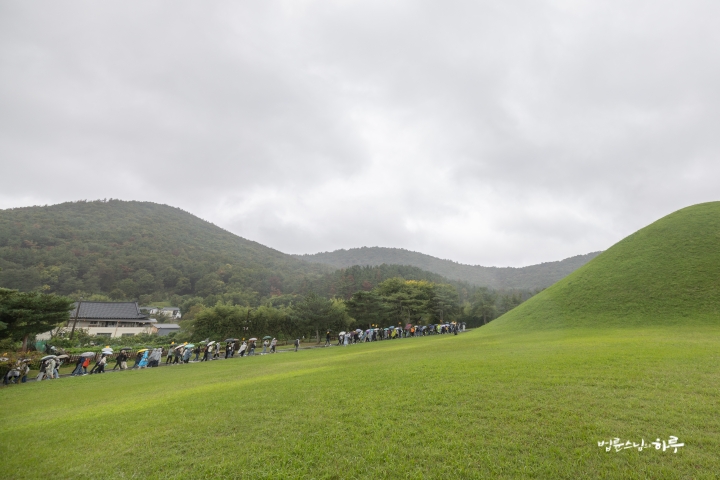
After taking a group photo, Sunim headed towards General Kim Yu-sin’s tomb.
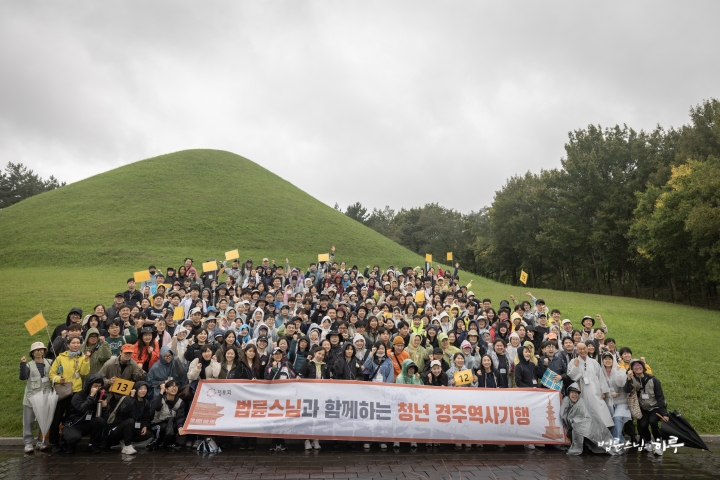
“Young people, fighting! Let’s go for unification!”
Originally, the plan was to walk, but due to heavy rain, they took a bus instead.
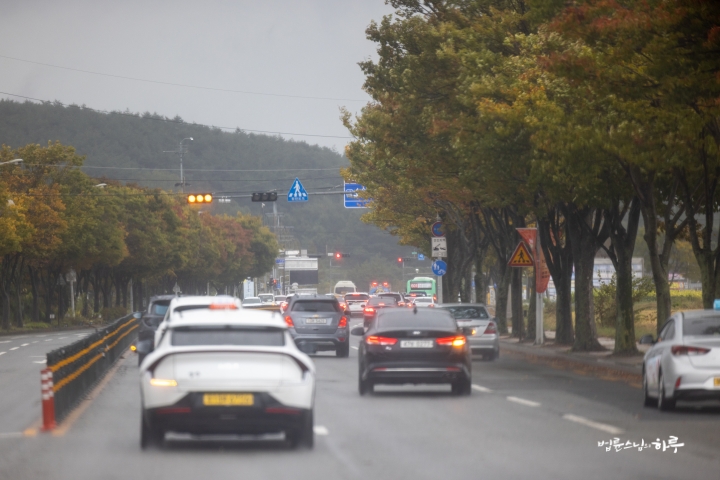
When all the young people arrived at General Kim Yu-sin’s tomb, Sunim continued his explanation while they stood under umbrellas.
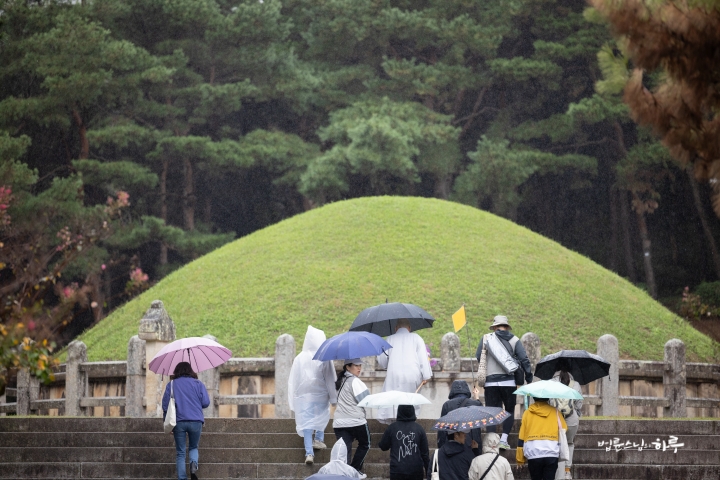

“This is General Kim Yu-sin’s tomb. General Kim Yu-sin was a royal descendant of Gaya. When Gaya and Silla unified, Silla, out of respect for Gaya, arranged for the person who was supposed to become king of Gaya to marry a Silla princess, thus accepting him as a son-in-law. They made Seorabeol, the capital of Silla, the primary capital and Gimhae, the capital of Gaya, the secondary capital. If North and South Korea were to unify, it would be like making Seoul the primary capital and Pyongyang the secondary capital. This was Silla’s unification policy with Gaya. General Kim Yu-sin was the great-grandson of King Guhyeong, the last king of Gaya. In other words, Kim Yu-sin’s mother was a Silla princess.
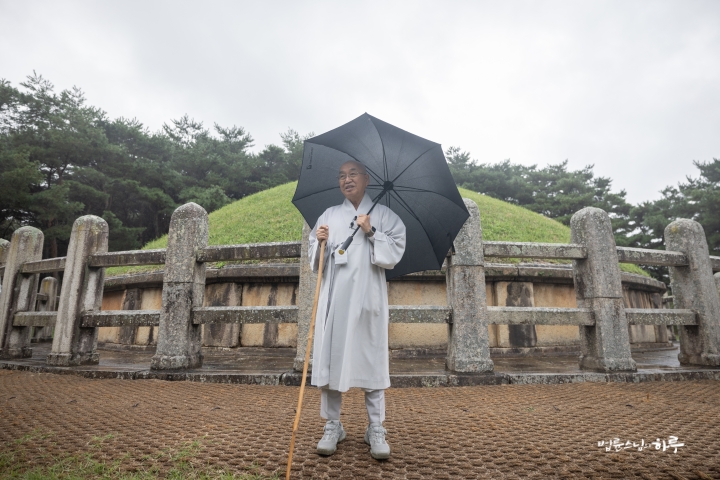
Most mothers want their children to succeed, right? But because Kim Yu-sin was from Gaya, it was easy for him to be criticized for even small mistakes in Silla. As a result, his mother seems to have raised him very strictly, fearing he might make a mistake. Consequently, although Kim Yu-sin was from Gaya and had the status of a subject, he was so respected in Silla that he was given the title of king posthumously.
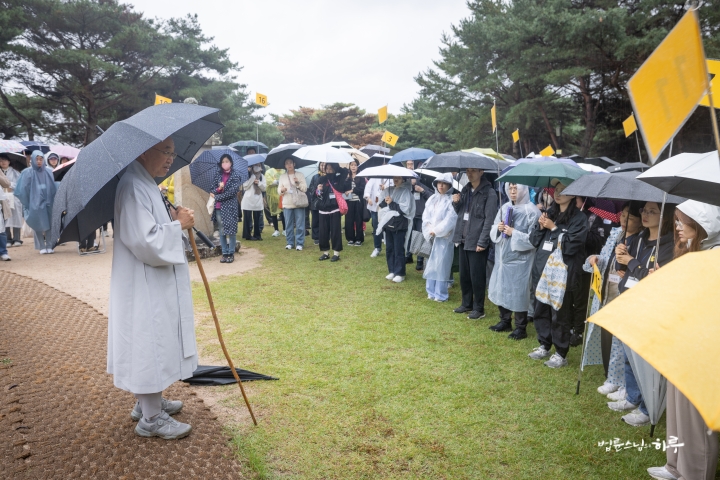
If you read about Kim Yu-sin’s youth, it seems that while he was an excellent son in his mother’s eyes, he might not have been considered such a great man from his partner’s perspective.”
Sunim continued to tell interesting stories about Kim Yu-sin’s youth.
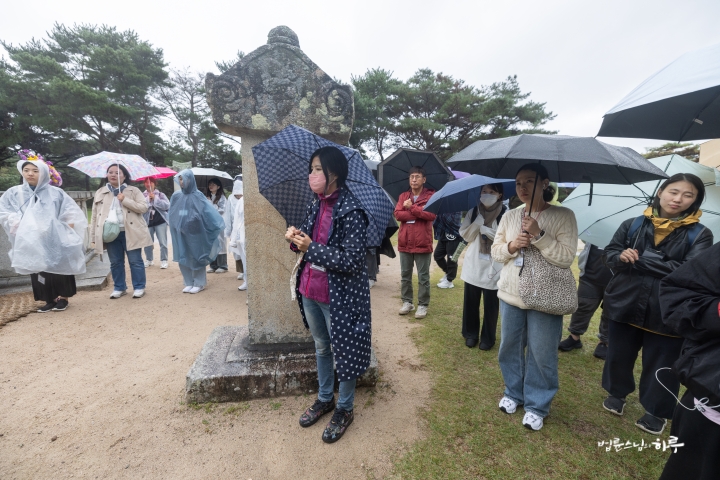
King Taejong Muyeol, his son King Munmu, and General Kim Yu-sin are considered the three heroes of Silla’s unification of the Three Kingdoms. Sunim unfolded the story of how Silla grew dramatically, centering on these three figures.
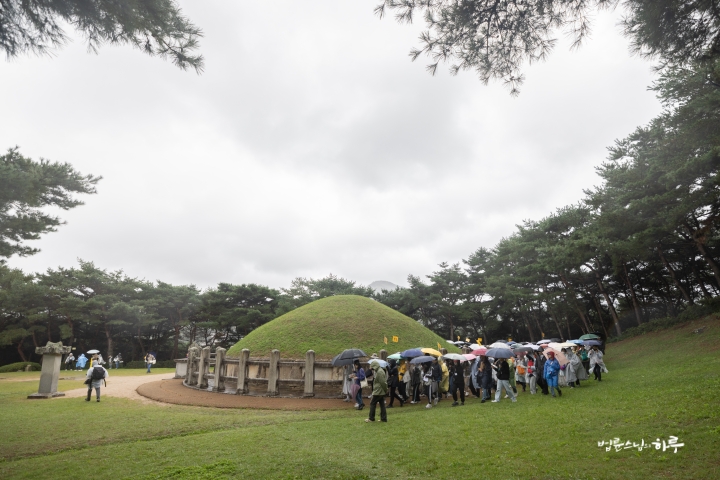
After listening to the explanation, they came down from General Kim Yu-sin’s tomb and took a photo standing on the stairs. The wide staircase was filled with young people.
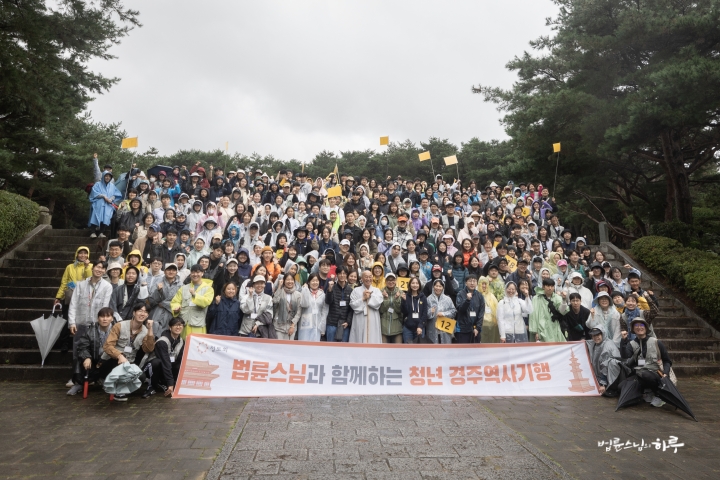
Leaving General Kim Yu-sin’s tomb, they arrived at Nangsan, which was considered sacred by the Silla people. They visited the site of Sacheonwangsa Temple, Queen Seondeok’s tomb, and Neungji Tower, built at King Munmu’s cremation site, in order.
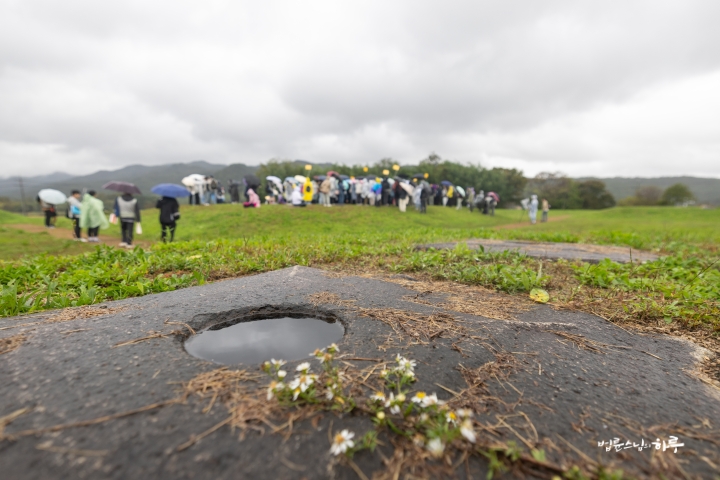
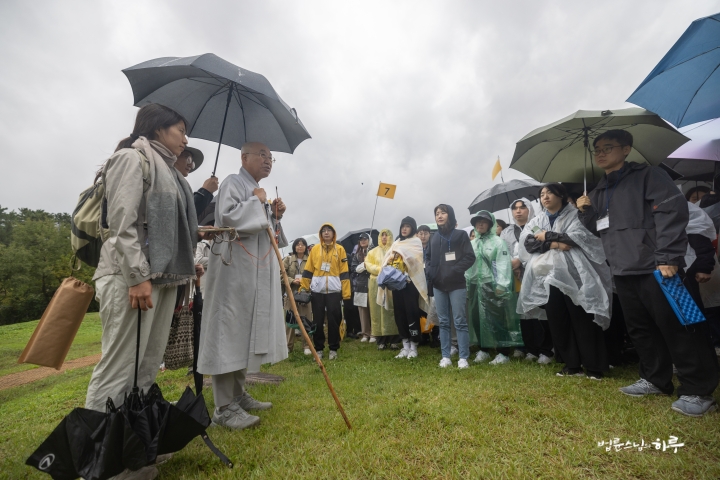
The site where Sacheonwangsa Temple once stood is now an empty lot, but traces of where the temple and pagoda were built have been restored.
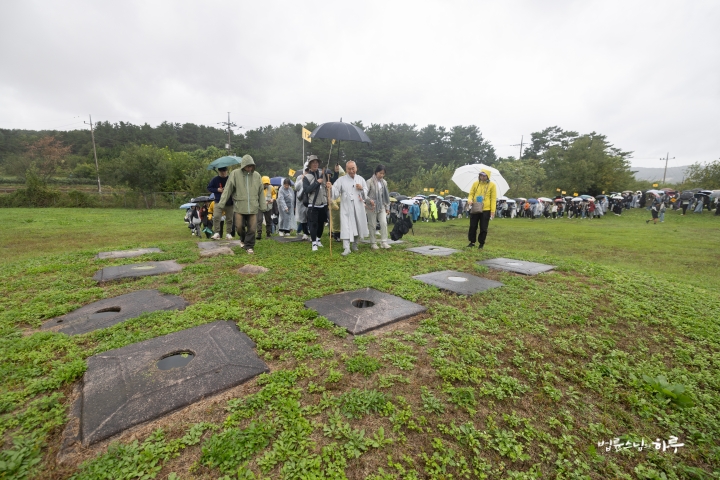
After touring the site where 12 Yogacara monks performed the Munduru ritual, following Sunim, they walked along a mountain path towards Queen Seondeok’s tomb.
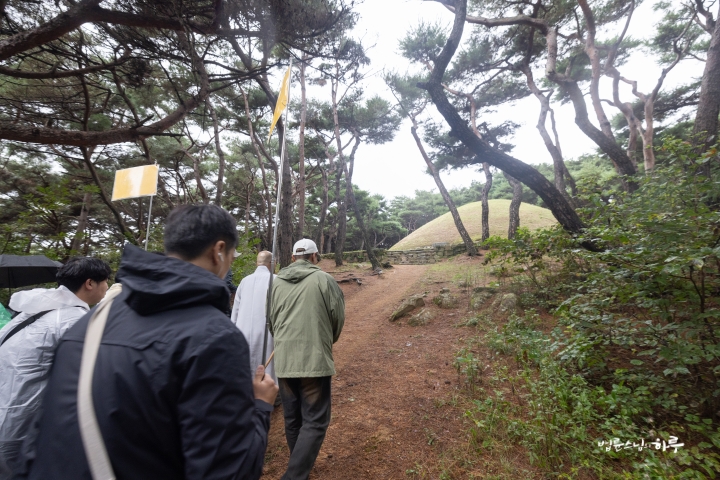
As the young people gathered and sat down next to Queen Seondeok’s tomb, Sunim continued his explanation.
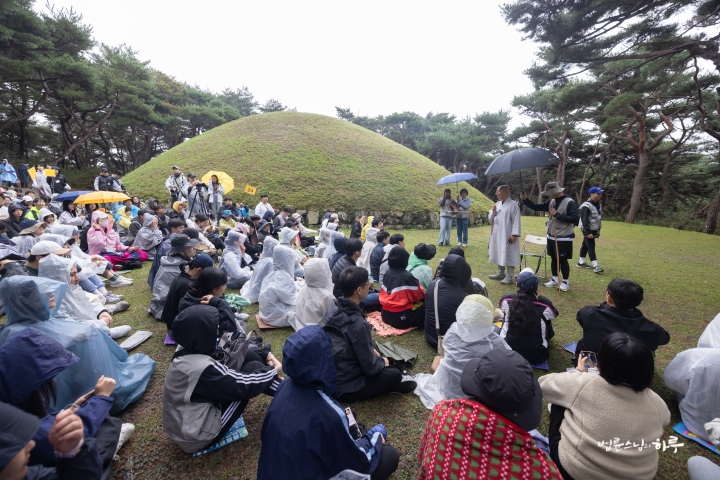
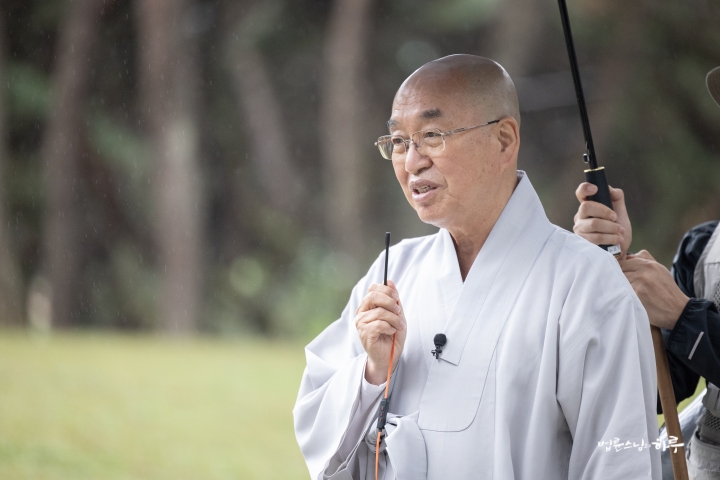
“We have arrived at Queen Seondeok’s tomb. Queen Seondeok was the 27th ruler of Silla. She was the first woman to become a monarch in our country. Although Queen Seondeok didn’t achieve unification during her reign to become a shining hero in history, she laid the foundation for unification through diplomacy with Tang China and nurturing talented people.
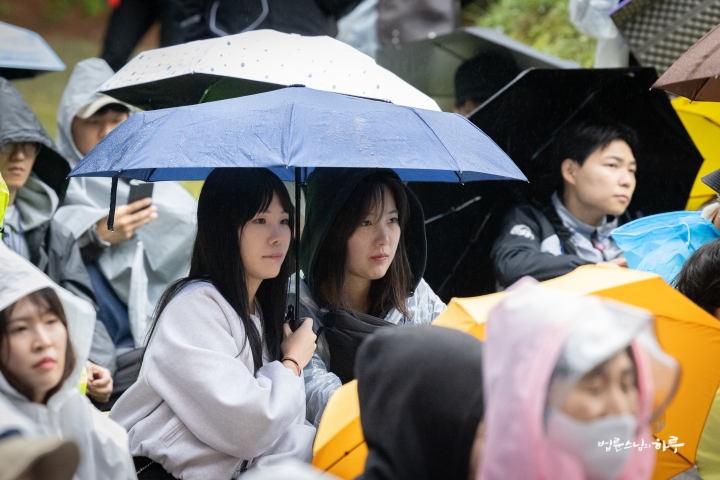
During Queen Seondeok’s time, the country was in a very difficult situation both internally and externally. Baekje kept invading, and there were frequent rebellions within the country. Because a woman was the ruler, there were several rebellions with people saying, ‘How can you be a queen? I should be the one.’ Despite such chaos, if we look at how Queen Seondeok prepared for the future, there are many lessons we can learn. Even in this gathering, there are more women than men, right? I think that in the future, female leadership will play a very important role in peace and unification on the Korean Peninsula.
Queen Seondeok is said to have been very wise. There are three anecdotes passed down about her wisdom, one of which is…”
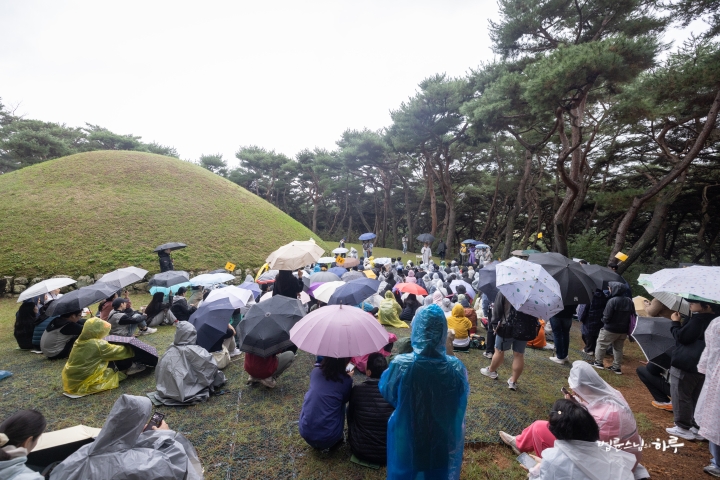
All the young people felt proud to hear that female leadership had already played a significant role on the Korean Peninsula 1,400 years ago. Sunim explained three anecdotes demonstrating Queen Seondeok’s brilliant wisdom and the reason why her tomb is located here.
After the explanation, the young people sang songs they had prepared. One person sang “On a Wonderful Day in October” and another played the violin.
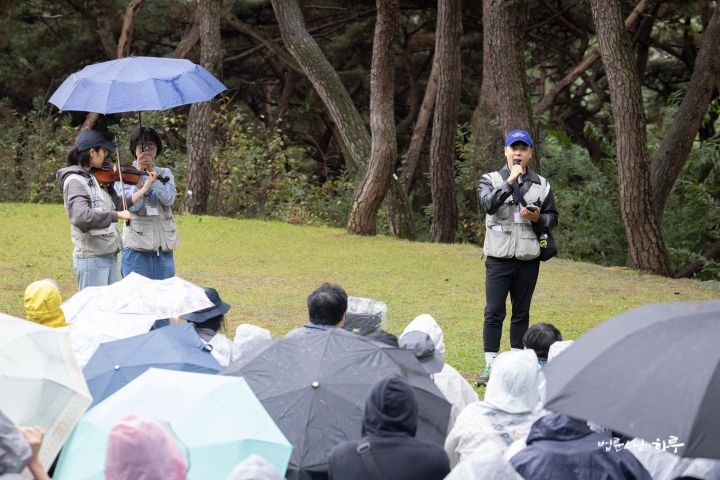
The Reason to Live, the Reason to Dream
It’s All Because of You
While You’re in This World
There Will Be Nothing Better
On a Wonderful Day in October ♬
The sun was already setting. The group descended the mountain path again and headed towards Neungji Pagoda, built at King Munmu’s cremation site. As the rain got heavier, Sunim wrapped up his explanation briefly.
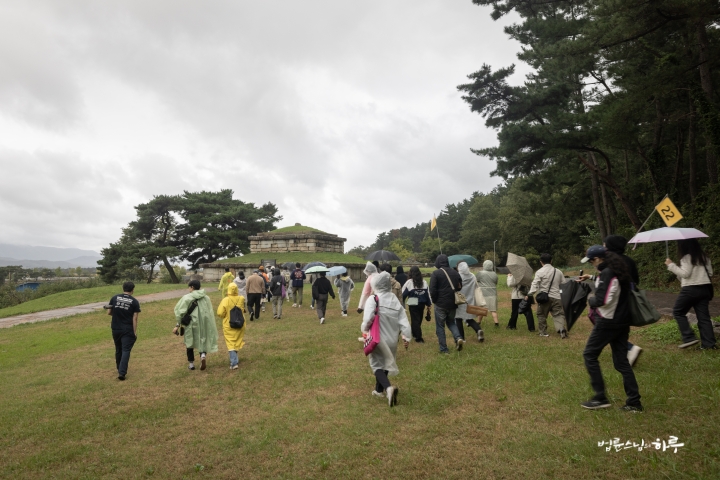
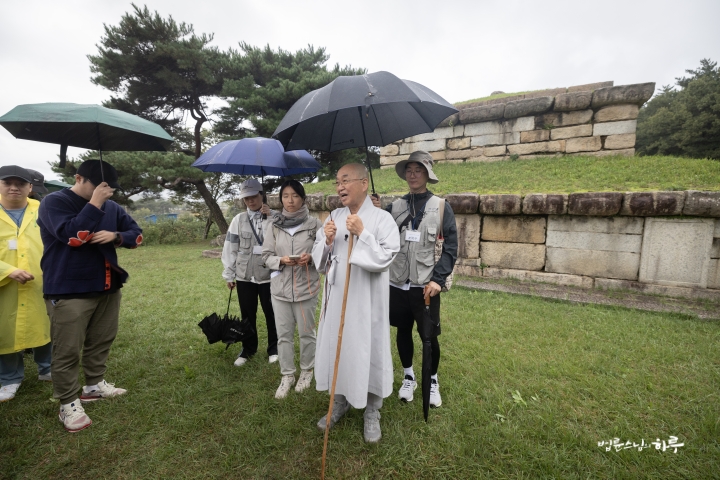
“It’s been raining all day. This is our last stop. This place is called Neungji Pagoda. King Munmu left a will saying, ‘When I die, cremate me and bury me in the East Sea.’ This is the very place where King Munmu was cremated.
So what is Neungji Pagoda? Usually, when a king dies, his body is buried and a royal tomb is built. However, since King Munmu was cremated, they didn’t build a tomb but erected a pagoda instead. Did they bury his ashes here? No, they didn’t. His ashes were buried at Daewangam Rock in the East Sea. This pagoda was built in place of a tomb. That’s why it’s called Neungji Pagoda.
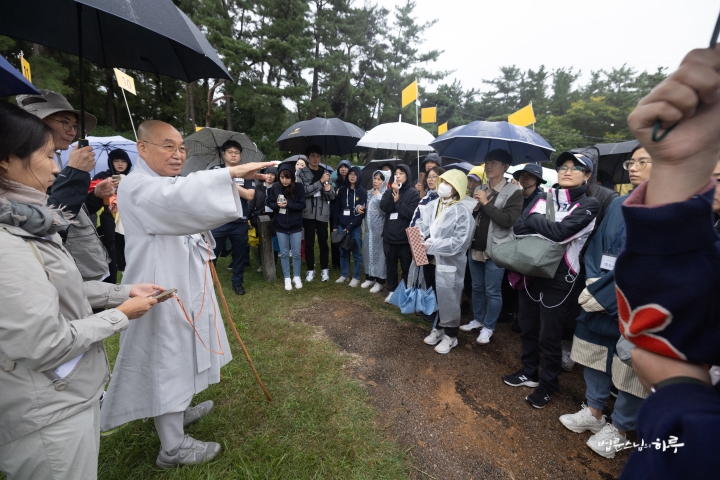
It’s said that back then, whenever people passed by this place, they would bow. Buddhists would bow because it’s a pagoda, and non-Buddhists would bow because it’s the tomb of the king who unified the Three Kingdoms. It’s said that everyone who passed by would bow here, which is why this neighborhood is called ‘Baeban (拜盤)’. It uses the Chinese characters for ‘bow (拜)’ and ‘rock (盤)’. It means that anyone who passed by this place would bow.”
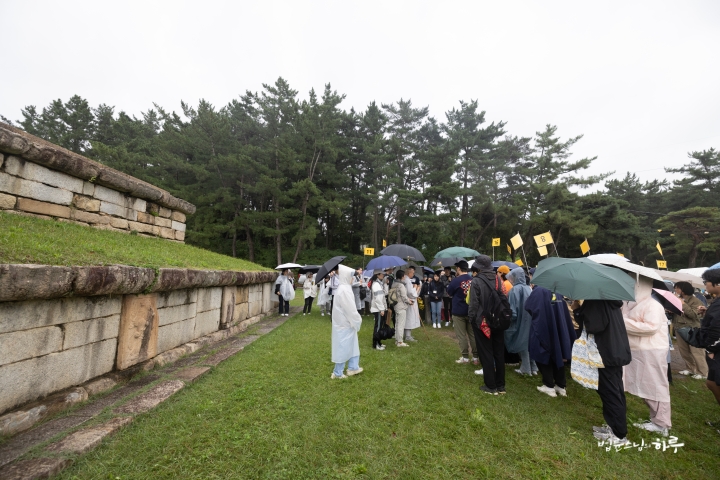
After leaving the Neungji Pagoda, Sunim took a bus to the accommodation. After dinner, everyone gathered in the auditorium at 7 PM for a Dharma Q&A session.
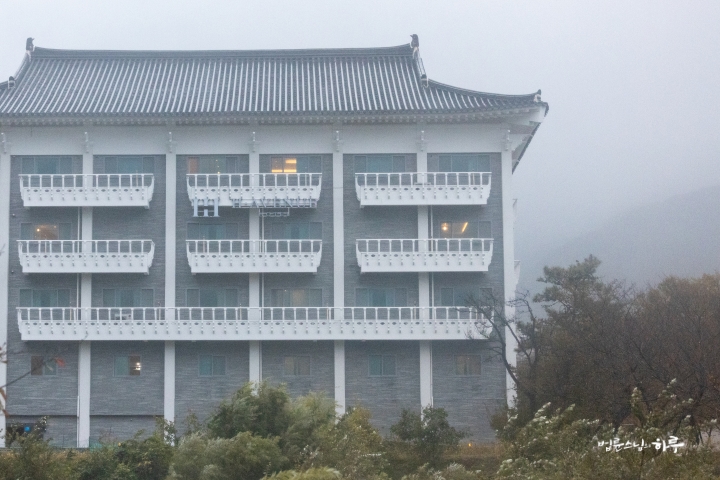
First, the group watched an opening performance prepared by the youth. Young people who had recently participated in the Seonjae Youth Program at Sujata Academy in India presented a dance performance.
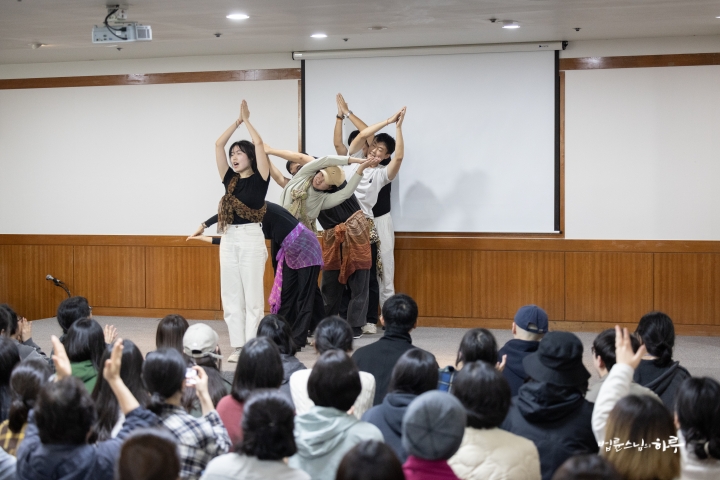
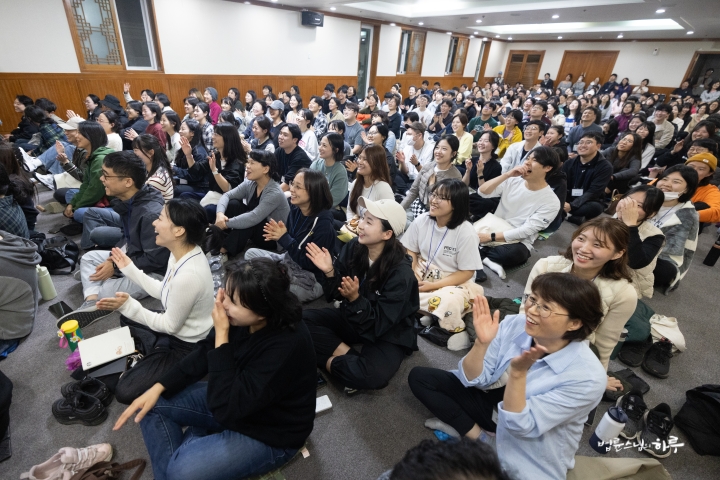
The auditorium was quickly filled with the energy of the young people. As the introductory video for Sunim ended, he took the stage amidst loud applause.
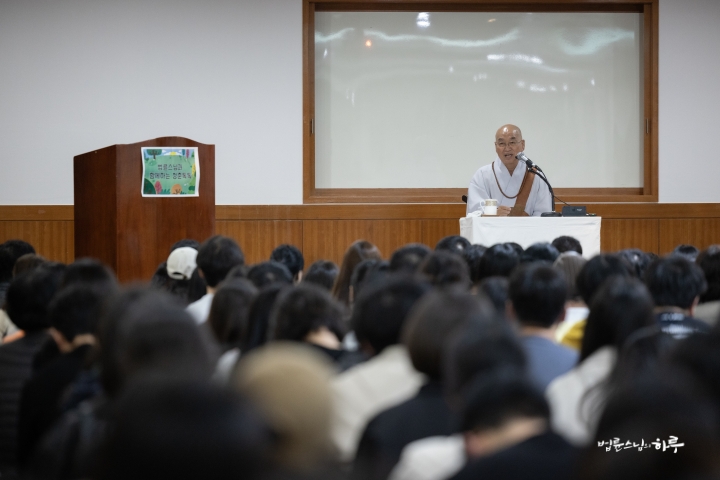
“Was it okay to visit various places despite the rain?”
“Yes.”
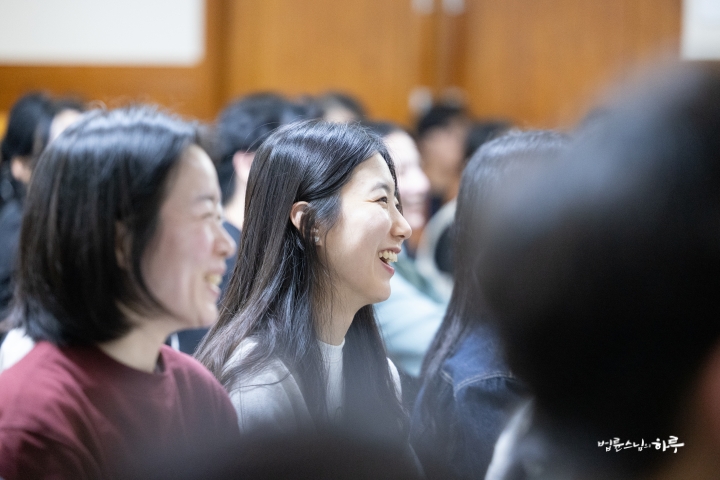
“Wasn’t it difficult?”
“It was nice to walk around in the rain.”
Then, a young person came on stage and energetically sang a song, after which Sunim began the Dharma Q&A. Various questions followed, covering topics such as dating, family, social life, mind, and history. One person sought Sunim’s advice, expressing fear of expressing their feelings after several unsuccessful blind dates.
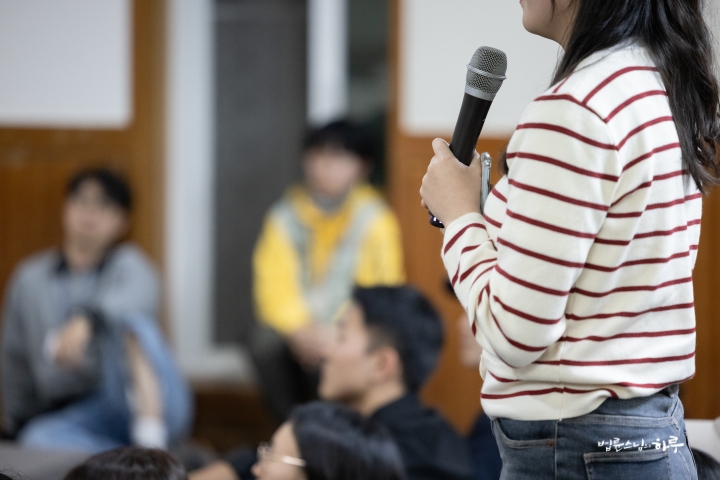
My Self-Esteem Drops After Repeated Failures in Blind Dates
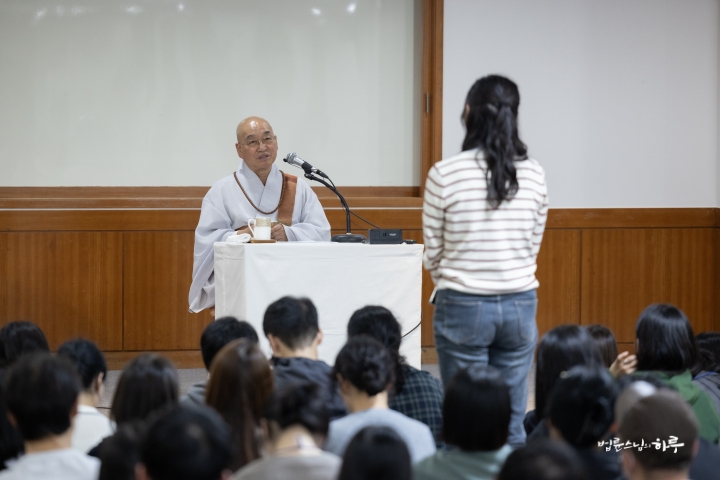
“If you’re still craving for the other person like this, you’re not even a half-moon yet.”
“I see.” (Everyone laughs)
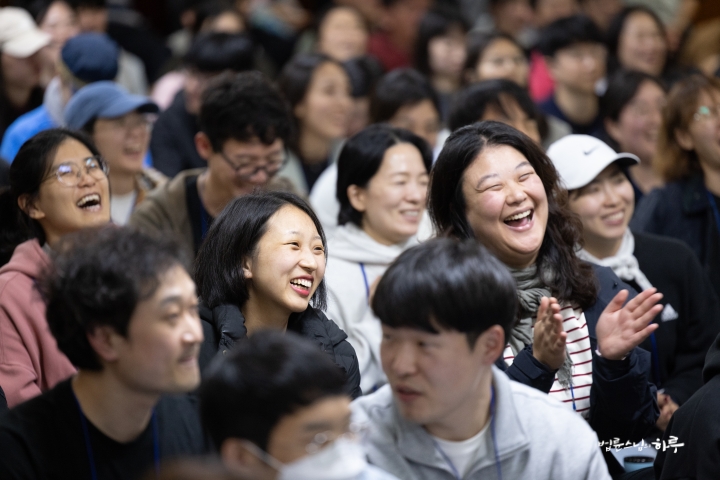
“To become a full moon, you should have no cravings. Without cravings, you can simply enjoy meeting someone, and be fine if you part ways. If you both like each other, then you can start dating. This way, there won’t be much conflict when you’re together, and there won’t be much hurt if you separate. When two half-moons meet, it may look like a full moon on the outside, but there’s still a crack in the middle, making it difficult to truly bond. However, when two complete circles overlap, they create a perfect circle without any cracks. That’s why even if one circle moves away, the other circle remains intact. While this might not be easy to put into practice, this is what dating looks like from a Buddhist practical perspective.”
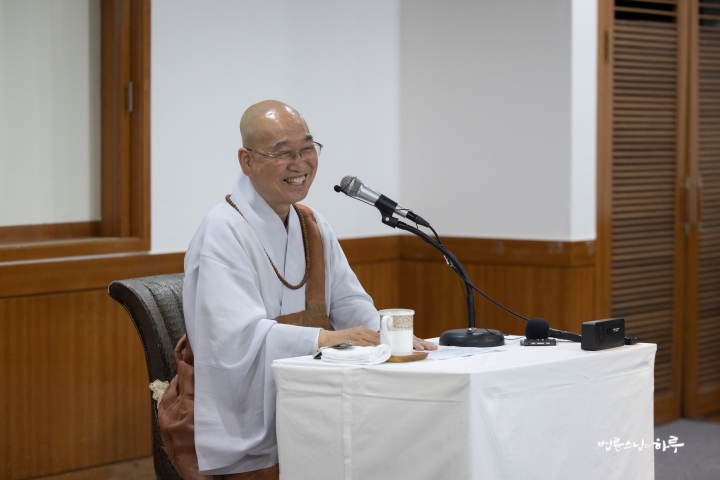
“Having a mindful perspective means being content living alone, having no issues living with someone if they suggest it, feeling only slightly disappointed if you part ways but moving on without major problems, and then if you start living with someone else, you might feel a bit awkward at first, but after a few days, you adjust without issues. This is what it means to have self-completeness. Saying you can’t live with others or that you must live with someone else both indicate a lack of self-completeness. A self-complete person is fine living with others or alone. The fact that you’re going on blind dates suggests you haven’t yet formed a complete circle. There are so many people here, why do you need to go elsewhere for blind dates?”
“Then, may I introduce myself to the people here?”
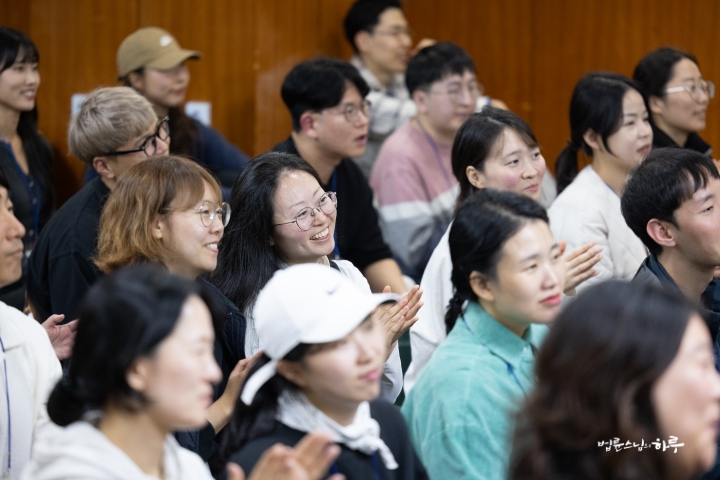
The questioner turned around and introduced herself to the audience. As everyone burst into laughter, Sunim continued.
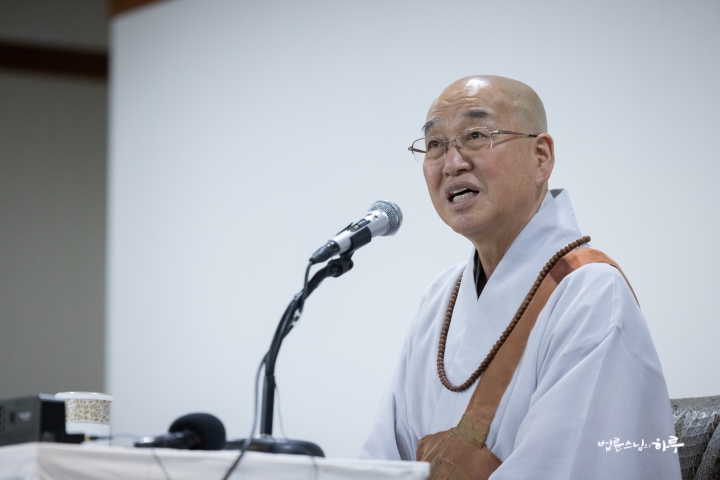
“To form relationships, first, don’t discriminate based on age. Thirty is fine, forty is fine, fifty is fine, sixty is fine – just think that as long as they’re not a minor, it’s okay. In society, minors are protected, so engaging with minors is considered a crime. Having an older partner is not a problem at all. Second, disregard gender and occupation. Don’t consider whether they’re male or female, or what job they have. Just think that as long as they’re human, it’s fine, and interact with them. This is the most basic principle in forming human relationships.
For two people to date within these human relationships, there needs to be mutual affection. The word ‘ae (愛)’ means love, so there needs to be love between them. Without love, a very close relationship is called friendship. Dating means having mutual love. People who meet for business have a business relationship, people who meet each other just because they like each other, without any interests involved, are friends, and those who meet with sexual love have a romantic relationship. A romantic relationship forms when feelings develop within an established human relationship. However, a romantic relationship doesn’t form if only one person has feelings for the other. It doesn’t work if only the other person likes you either. It’s not established by one-sided affection; it requires mutual attraction. Even if I like someone, the probability of a romantic relationship forming is less than 50%, and it’s the same if someone likes me. It’s because both need to like each other. Just as multiplying 0.5 by 0.5 gives 0.25, mathematically, the probability of someone I like also liking me back is only 25%. This means that out of four attempts, only one is likely to succeed. Therefore, a relationship doesn’t automatically form just because I like someone.
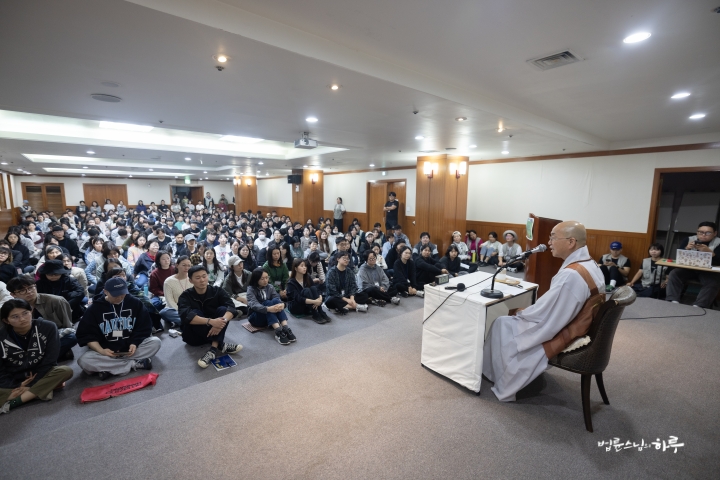
Just as age and gender are irrelevant in human relationships, they can also be irrelevant in romantic relationships. This is because dating does not yet establish a special family relationship. Therefore, romantic relationships can transcend national borders, age differences, and social status.
However, marriage is somewhat different. It’s more difficult for marriage to transcend gender. While homosexual dating is possible, homosexual marriage often faces social resistance. Additionally, while dating is possible regardless of age, marriages with large age gaps often encounter various forms of resistance. Dating can occur regardless of nationality, but international marriages often face resistance from families. Dating can transcend social status, but marriages that cross social boundaries often face significant opposition. In India, for example, people sometimes lose their lives due to relationships that cross caste lines. Particularly, if a high-caste woman dates or marries a lower-caste man while in college, her brothers might even kill the man. This is called “honor killing,” and reportedly, thousands of such honor killings still occur annually in India. This illustrates how difficult it is for marriages to transcend social status. While interfaith dating is possible, marriages between people of different religions often face challenges in overcoming resistance from their surroundings.
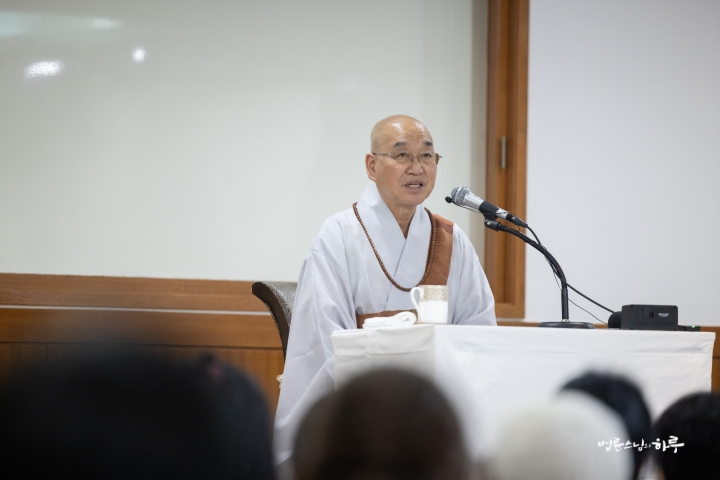
While dating only requires mutual affection between two people, marriage involves the man’s mother becoming the woman’s mother, and vice versa. This can lead to family opposition when there are differences in age, gender, or religion. In such cases, agreement or consensus within the family is necessary. When conflicts arise without consensus, the couple must choose between seeking a marriage that has family approval or being prepared to endure potential estrangement from their families for the sake of their union. However, most people want both to get married and maintain family relationships, which often leads to inner conflict.
If there’s a twenty-year age gap between partners, families are likely to object. Similarly, same-sex marriages, unions between people of different social classes in places where such distinctions persist, or marriages involving differences in nationality, ethnicity, religion, or economic status often face family opposition. When family resistance is strong, it can cause the individuals involved to hesitate as well. This is why dating and marriage should not be viewed as the same thing.
One of the most common mistakes made by those about to get married is equating dating with marriage. There is a significant difference between the two. While dating primarily revolves around mutual affection, marriage involves forming a community, making family approval an important factor. Nevertheless, if one prioritizes personal feelings over family consent, they should be prepared for the possibility of severing family ties.
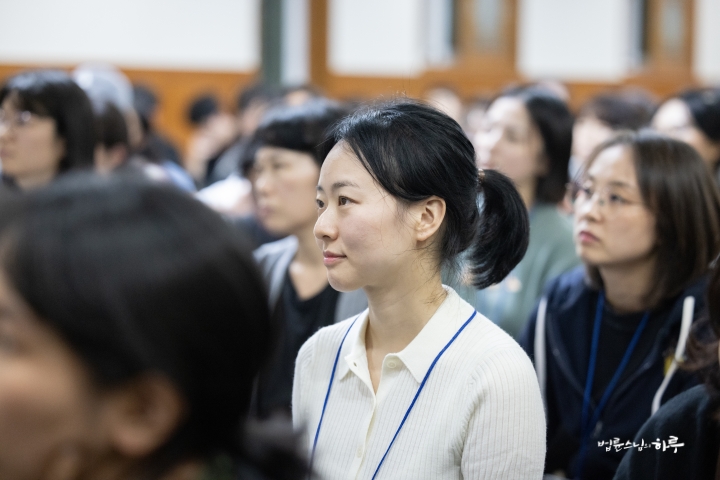
Cutting off family ties is not always wrong. Family relationships can sometimes become estranged as life unfolds, but severing these ties isn’t easy due to the long history shared within the family. Such disconnections can occur in various situations, not just in marriages. For instance, when someone converts to a different religion, they may experience some degree of separation from their former religious community. Similarly, changing one’s nationality can break ethnic ties. In the same way, choosing to marry against family opposition can lead to a disconnection in relationships. It’s important to be aware of this possibility when making such a decision.
If one makes this choice with full awareness, there’s no issue. However, problems arise when couples decide to marry based solely on their mutual affection, without deeply considering these aspects, only to face difficulties when their parents object. In such cases, claiming that they can’t marry because of parental opposition is pointless. This is because it’s not primarily the parents’ issue; rather, it’s a matter of understanding the nature of marriage and making a personal choice from the beginning. In other words, it’s up to the individual to decide whether to marry despite family opposition or to refrain from marrying due to anticipated family objections. Blaming others for one’s inability to make a decision is inappropriate.
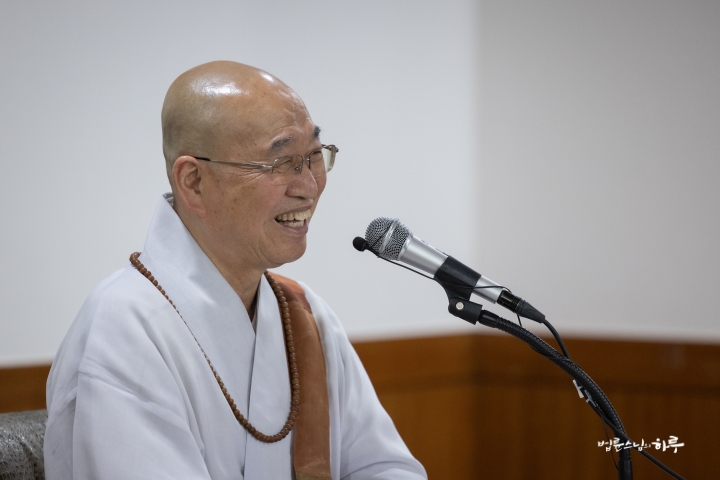
When someone under 20 wants to get married, they need parental consent because they are still minors. However, adults over 20 don’t need parental consent. If they want to marry, they can just do so. But if one wants to both get married and obtain parental approval, it creates inner conflict. For adults, parental consent is not necessary for any choice they make. However, if they want to get money or an apartment from their parents, they might need to stay in their good graces, so approval becomes necessary. But this is a matter of personal interest; looking at marriage itself, parental consent is not strictly necessary. If someone says they can’t marry because their parents object, there’s no need to marry someone so lacking in independence. Marrying such a person would likely cause more headaches later because they can’t make decisions on their own and always consider their family’s opinions. To get married, one should either clearly settle family relationships and decide to marry, or conclude that while there are mutual feelings, marriage should be postponed. Making a clear stance like this allows for a life without regrets later.
When meeting people, if you approach with the intention of finding a marriage partner from the start, you might not succeed even after meeting 100 people. Even when a stranger approaches, people are initially cautious, so imagine how burdensome it would be if someone approached with the immediate intention of marriage. The other person wasn’t born to be your marriage partner, and you weren’t born to be theirs either. It’s not just about marriage; it’s not polite to the other person to approach with the intention of dating from the start. These days, young people have meetups for dating and introductions for marriage, but in fact, approaching people with such predetermined goals can be seen as denying the other person’s individuality. If you meet people without any specific purpose, you might become friends, develop romantic feelings if you like each other, or even get married if you both agree. Approaching with the intention of dating or marriage from the start can be seen as having the wrong motivation. Wouldn’t you feel uncomfortable if someone approached you saying, “Let’s date” or “Let’s get married” right away? So it’s better to think, “Since I’ve only been working at my company, I haven’t had chances to meet people, so I’ll go to these events to meet someone.” As you meet people, you might become friends, or it might just be a one-time encounter.
The concern you’re having now stems from setting a goal with a very low probability of success. This is not a punishment from God, nor karma from a past life, nor is it because the matchmaking agency is not good. It’s happening because you’re approaching with a very low probability from the start.
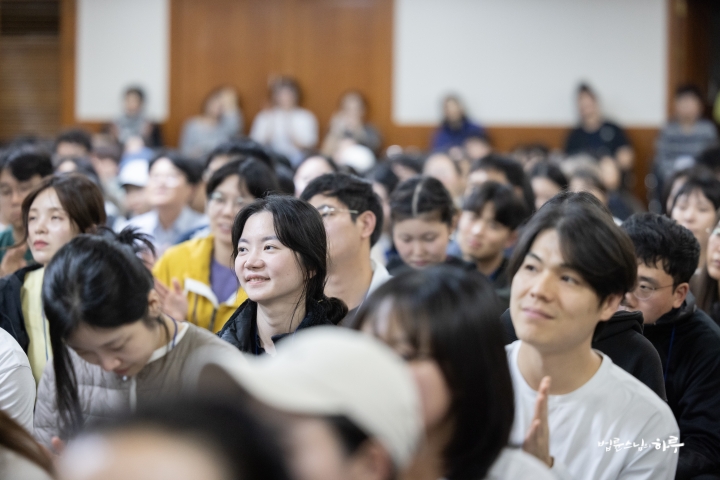
“If you look around, you’ll occasionally see people who successfully get married after just one blind date. But have you ever calculated the probability of that happening? It’s very low. It only happens occasionally because many people go on blind dates, but the success rate is quite low. So, if a blind date doesn’t work out, it’s not particularly bad, and there’s no problem at all. Right now, you’re like someone who bought a lottery ticket with a very low chance of winning and is asking, ‘Sunim, I’ve bought lottery tickets ten times, why haven’t I won even once?’ This happens because you’re challenging something with a very low probability of success from the start.”
“Yes, thank you.”
“It seems that more and more young people are having these concerns these days. Why do you try to meet people with intention in such good times as these? Wouldn’t you feel uncomfortable if someone approached you with a specific intention? It’s not desirable to approach someone for their money, for a sexual relationship, for dating, or for marriage. It’s better to just meet as one person to another, and let relationships develop naturally, rather than setting goals to approach strangers. Approaching relationships with set goals is like buying items from a store. I don’t think it’s desirable to approach human relationships this way. So, even if you go on blind dates in the future, don’t emphasize your goals too much. It’s better to think lightly, like ‘I don’t have many chances to meet people and I’m bored, so I’ll give it a try.’ Also, isn’t a place like today’s gathering good for meeting people?”
Two hours have passed since the Dharma Q&A began. The last questioner asked if Sunim had any message for young people regarding peace and unification on the Korean Peninsula.
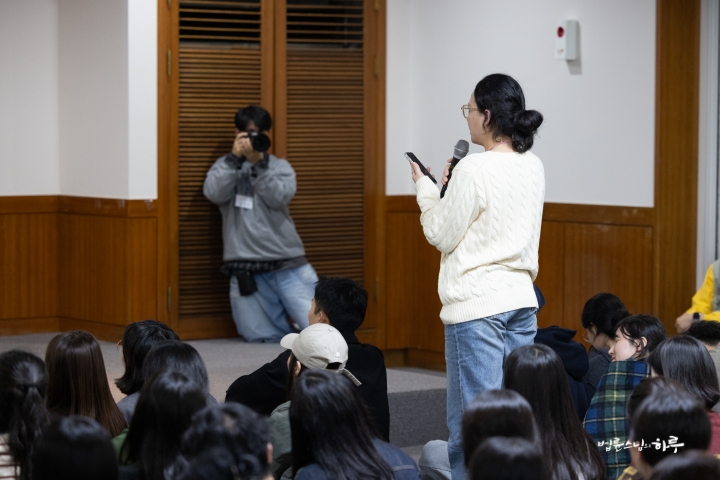
Sunim urged the young people to become the generation that achieves unification.
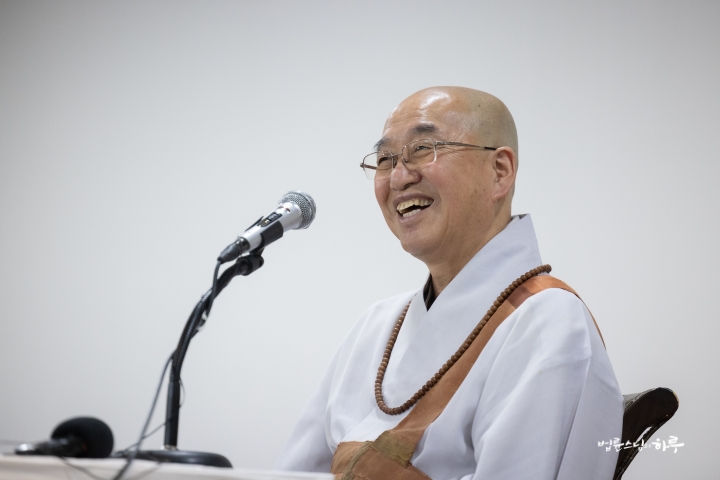
“Unification will be a new hope for you. During the Japanese colonial period, people suffered greatly, but the youth of that era have pride in having participated in the independence movement. The next generation endured war but takes pride in having built their homeland. The following generation has pride in democratization. Although some were imprisoned and even died in the process, we have pride in being the generation of democratization. However, today’s young generation lacks pride in contributing to the nation’s development. Instead, they cry out ‘Hell Joseon,’ showing a lack of national pride. But what if your generation achieves unification? If that happens, you will have a much greater historical pride than previous generations. You’ll have a completely different level of pride, saying, ‘It was finally in our time that we resolved the 100-year-old resentment.’ In this respect, I hope you all maintain a positive perspective on unification.”
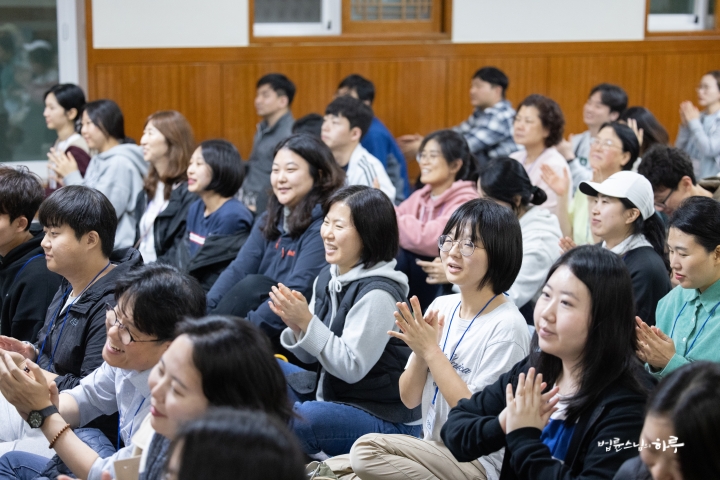
Although many young people still wanted to ask questions, it was decided to continue the conversation tomorrow. The Dharma Q&A session concluded after 9 PM.
Despite the late hour, the youth gathered in groups for a time of sharing their thoughts and feelings. As the atmosphere of the history tour deepened, the heavy rain that had been pouring finally stopped.

Tomorrow morning, the group will travel to the East Sea to visit King Munmu’s underwater tomb, Gameunsa Temple site, and Bulguksa Temple. In the afternoon, they will hold a closing ceremony at Hwangnyongsa Temple site, concluding the youth history tour of Gyeongju. In the evening, Sunim will participate online in a public hearing with group facilitators to discuss the development of Jungto Society.”




